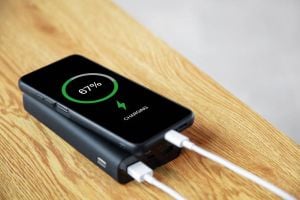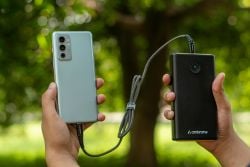
When choosing a power bank, one of the first specifications people tend to check is the mAh rating. This number has become a common benchmark for measuring power bank performance, but many users may not fully understand what it represents or how much capacity they actually need.
Today, with the widespread use of 5G smartphones, foldable devices, and battery-intensive wearables, having a reliable power bank is increasingly important for staying connected throughout the day. Our daily reliance on apps for navigation, communication, entertainment, and work means that portable charging is no longer just convenient — it’s often essential.
Understanding what mAh means, how it translates into real-world charging capability, and how to choose the right capacity based on your usage is key to making an informed decision. This guide will explain the essentials, helping you select a power bank that suits your lifestyle.

Editor
Mae An NG chevron_right
Table of Contents
What is mAh in Power Bank?
mAh stands for milliampere-hour, a unit that measures electric power over time. In simpler terms, it tells you how much energy a battery can store. The higher the mAh number, the more charge the power bank can hold, and the more times it can charge your device.
For example, a 10,000mAh power bank can charge a smartphone with a 3,000mAh battery about 2 to 2.5 times, depending on efficiency losses. It's similar to how a larger fuel tank in a car allows you to drive longer without refueling.
How Much mAh Do You Need?

The ideal capacity depends on your typical device usage and how often you need to recharge on the go. Here’s a general guide:
Light Users (Occasional phone top-ups)
- Recommended: 5,000mAh–10,000mAh
- Suitable for individuals who mostly charge at home or the office but want backup during the day.
- Compact and travel-friendly.
Moderate Users (Regular daily use, including maps and video streaming)
- Recommended: 10,000mAh–20,000mAh
- Can charge a smartphone 2–3 times.
- Ideal for people commuting, attending events, or going on short trips.
Heavy Users (Multiple devices, creators, travellers)
- Recommended: 20,000mAh–30,000mAh
- Supports multiple full charges for phones, tablets, or wearables.
- Suitable for frequent travelers, remote workers, and content creators.
Do Bigger mAh Numbers Mean Better?
Not always. Bigger capacity also means the power bank is larger and heavier. If you want something easy to carry in your pocket, go for 5,000mAh or 10,000mAh.
But if you travel often or use your phone a lot for games and videos, then yes — a 20,000mAh power bank will last you much longer.
How to Calculate the Right Size
Want to know exactly what size you need? Here’s a simple formula:
- Check your device’s battery size (in mAh). For example, most smartphones have 3,000mAh–5,000mAh batteries.
- Decide how many times you want to charge your device before recharging the power bank.
- Multiply your phone’s battery size by the number of charges you want.
- Add 20% to cover energy loss (power banks are not 100% efficient).
Example:
Your phone battery = 4,000mAh
You want 2 full charges: 4,000 × 2 = 8,000mAh
Add 20%: 8,000 × 1.2 = 9,600mAh
So, a 10,000mAh power bank is just nice for you
Device Battery Sizes – A Quick Reference
Understanding your own device’s battery size helps in estimating how many full charges you’ll get. Here are typical battery capacities:
|
Device |
Battery Size |
Approx. Charges with 10,000mAh Power Bank |
|
iPhone 15 |
~3,300mAh |
2.5 times |
|
Samsung Galaxy S24 |
~4,000mAh |
2 times |
|
iPad (10th Gen) |
~8,500mAh |
1 time |
|
Wireless earbuds case |
~500mAh |
15+ times |
|
Smartwatches |
~300–500mAh |
15–20 times |
Efficiency Losses: Why You Don't Get the Full Capacity
It’s important to note that a power bank’s mAh rating refers to its internal battery. However, during use, some energy is lost due to:
- Voltage conversion (most phone batteries operate at 3.7V while power banks output at 5V)
- Heat generation
- Circuit inefficiencies
As a result, usable capacity is usually around 65% to 75% of the listed mAh. For example:
- A 20,000mAh power bank typically delivers around 13,000mAh to 15,000mAh of real-world charging power.
This is still sufficient for several full phone charges, but it's helpful to understand the practical output before purchasing.
Charging Speed Matters Too
Aside from capacity, you should also consider how fast the power bank can charge your devices. Look for:
- Wattage (W): Higher wattage means faster charging. A minimum of 18W is recommended for most modern smartphones.
- USB Power Delivery (PD): Ideal for iPhones, newer iPads, and some laptops.
- Quick Charge (QC 3.0/4.0): Common in Android devices for fast charging support.
Many modern power banks offer dual or triple outputs, including USB-C, which is now the industry standard that supports USB-C fast charging.
What Else Should You Consider?
Air Travel Limits
According to international airline regulations, most carriers (including AirAsia, Malaysia Airlines, and Firefly) allow carry-on power banks rated below 27,000mAh (100Wh). Always check your power bank’s watt-hour (Wh) rating before flying.
Heat and Weather
Our hot climate can affect battery life. Avoid leaving your power bank in a parked car or under direct sunlight. Excessive heat can degrade battery health and even pose safety risks.
Buying Safe, Original Products
Be cautious of extremely cheap or unbranded power banks, especially on online platforms. Always buy from reputable brands. These brands typically comply with safety standards and include overcharge, overheat, and short-circuit protection.
Portability
Bigger mAh means bigger size and weight. If you travel light, stick to 10,000mAh or less.
Charging Speed
Look for power banks with fast charging (like USB-C PD or Quick Charge) if you want to power up quickly
Number of Ports
Need to charge more than one device? Choose a power bank with multiple USB ports.
Special Features - Are they worth it?
Wireless Charging Power Banks
These are convenient, especially for iPhone (MagSafe-compatible) and Android devices with Qi wireless charging. However, charging speeds are generally slower than wired options. They’re best used for light top-ups when convenience is a priority.
Solar Charging Power Banks
Some models offer solar panels for recharging. While this might sound ideal for Malaysia's sunny climate, in practice, solar recharging is slow and should be treated as an emergency backup feature only.
Summary: How to Choose the Right Power Bank
|
Factor |
What to Consider |
|
Capacity (mAh) |
Match your usage: 10,000mAh for daily users, 20,000mAh+ for heavy use |
|
Charging Speed |
Look for 18W or higher, with PD or QC support |
|
Number of Ports |
Multiple output ports help charge multiple devices |
|
Port Type |
USB-C is now standard for fast input/output |
|
Brand and Safety |
Choose reputable brands with safety certifications |
|
Size & Portability |
Higher capacity usually means larger size |
|
Travel Compliance |
Keep below 100Wh (approx. 27,000mAh) if flying |
Final Thoughts

That’s all you need to know about what is mAh in powerbank! Picking the right power bank capacity is easy once you understand your phone’s battery and your daily needs. Whether you want a light one for short trips or a big one for long days out, there’s a perfect power bank for you.
Make sure to shop smart, check the mAh carefully, and you’ll never run out of juice again!
